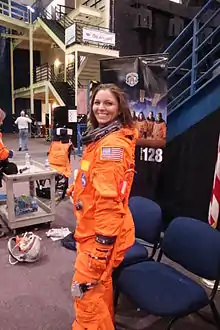Amber Gell
Amber S. Gell is an American engineer, scientist, and STEM (Science, Technology, Engineering, and Math) education advocate who specializes in human performance in extreme environments. A Milwaukee, Wisconsin native, she currently works for Lockheed Martin as a Program Manager. She has won awards for her accomplishments in space systems and educational outreach, including the 2010 Early Career Rotary National Award for Space Achievement[1] and the 2013 Adler Planetarium Women in Space Science Award.[2] She has a degree in aerospace engineering and business, and physiology, and is also a certified group fitness instructor, Wilderness First Responder (WFR), Master Scuba Diver. Amber is also a member of the Embry–Riddle Aeronautical University Mathematics Industry Advisory Board[3] and the Commercial Space Operations Industry Advisory Board.
Amber Gell | |
|---|---|
 Amber S. Gell | |
| Born | 1984 (age 36–37) |
| Nationality | American |
| Citizenship | United States |
| Education | Embry-Riddle Aeronautical University, Bachelors of Science Aerospace Engineering - Astronautics ERAU, Bachelors of Science Aerospace Studies - Human Factors, Mathematics, Psychology Stevens Institute of Technology, Masters of Engineering Space Systems Engineering University of Houston–Clear Lake, Master of Science Physiology - Fitness & Human Performance UHCL, Master of Science in Finance UHCL, Master of Business Administration (MBA) |
| Spouse(s) | Andrew Sherwood |
| Engineering career | |
| Institutions | AIAA, Senior Member ERAU, Computational Mathematics Industry Advisory Board ERAU, Commercial Space Operations Industry Advisory Board |
| Employer(s) | Lockheed Martin |
| Projects | Orion International Space Station |
| Awards | Women in Space Science Award 2013 |
Education
She received Bachelor of Science degrees in both aerospace engineering and aerospace studies from Embry–Riddle Aeronautical University in Daytona Beach, Florida. She subsequently earned a Master of Science degree in physiology and human performance from the University of Houston–Clear Lake.[4] She has a Master of Engineering degree in systems engineering from the Stevens Institute of Technology, and also a Master of Science degree in finance and a Master of Business Administration (MBA) degree, both from the University of Houston–Clear Lake.
Research
Her research includes Optimal Crew Selection for Long-Duration Spaceflight focusing on gender, culture, and personality characteristics, in which she contributed academic papers and presented her work at the Human Performance in Extreme Environments (HPEE) Conference,[5] Spacecraft Propulsion Technologies,[6] and Exothermic Welding in a Reduced Gravity Environment.[7][8][9] Amber is a published author that has contributed to advancements in the Physiology field.[10]
Engineering outreach
Gell has given presentations on her work to inspire others to pursue degrees in STEM. Presentations include the 51st AIAA/SAE/ASEE Joint Propulsion Conference,[11] Scientix Conference Keynote Speaker,[12] Irish Science Teacher's Association Keynote Speaker,[13] i.d.e.a. Museum BRIGHT i.d.e.a.s Fundraiser Keynote Speaker,[14] Mission Possible Week Keynote Speaker,[15] Conrad Spirit of Innovation Challenge Fireside Chat,[16] Lecture with Cosmonaut Anatoly Artsebarsky,[17] and many more. Amber was also a judge for the FIRST Robotics Competition at the Wisconsin Regional and FIRST Championship events in 2016. Amber has served as a judge for the FIRST Robotics Competition at the Wisconsin Regional annually since 2008 and the FIRST Championship events annually since 2011.[18][19]
References
- "2010 Rotary National Award for Space Achievement" (PDF). Retrieved 23 August 2015.
- Rebmann, Sara. "Celebrating Women in Space Science". adlerplanetarium.org. Retrieved 23 August 2015.
- "Mathematics Industry Advisory Board". erau.edu. Retrieved 4 September 2015.
- Gell, Amber. "Use of the Functional Movement Screen (FMS) to predict deficits in bilateral/unilateral force, power, and rate of force development". Retrieved 23 August 2015.
- "HPEE Fourth Annual Meeting". hpee.org. Retrieved 23 August 2015.
- Norris, Scott D.; Gell, Amber (2015). "Orion EFT-1 Propulsion Test Results". 51st AIAA/SAE/ASEE Joint Propulsion Conference. American Institute of Aeronautics and Astronautics. doi:10.2514/6.2015-3792. ISBN 978-1-62410-321-6.
- NASA. "NASA 2011 Reduced Gravity Education Flight Program Annual Report" (PDF). National Aeronautics and Space Administration. Archived from the original (PDF) on November 18, 2016. Retrieved April 28, 2016.
- "Feasibility and Reliability of Construction Techniques in a Reduced Gravity (0G or 1/6G) Environment". nasa.gov. Archived from the original on 5 March 2016. Retrieved 23 August 2015.
- "Aerospace scientist learns welding for future space missions". yourhoustonnews.com. Retrieved 23 August 2015.
- Gell, Amber S. (2010-01-01). Use of the Functional Movement Screen (FMS) to Predict Deficits in Bilateral/unilateral Force, Power, and Rate of Force Development.
- 51st AIAA/SAE/ASEE Joint Propulsion Conference Propulsion and Energy Forum. aiaa.org. 2015. doi:10.2514/MJPC15. ISBN 978-1-62410-321-6. Retrieved 23 August 2015.
- "Scientix Conference Keynote Speakers". scientix.eu. Retrieved 23 August 2015.
- "istacon2016". istacon2016. Retrieved 2016-04-28.
- "BRIGHT i.d.e.a.s Signature Event Press Release" (PDF). ideamuseum.org. Archived from the original (PDF) on 28 September 2015. Retrieved 23 August 2015.
- "Mission Possible Amber Gell Biography". theskillsservice.co.uk. Archived from the original on 2015-10-03. Retrieved 23 August 2015.
- "2014 Lockheed Martin Fireside Chat with Amber Gell". conradawards.com. Archived from the original on 28 September 2015. Retrieved 23 August 2015.
- Maxey, Gerry. "Amber Gell In Scotland, She Lectures With Legendary Russian Cosmonaut Anatoly Artsebarsky". themaxeychronicles.blogspot.com. Retrieved 23 August 2015.
- Richardson, Erik. "Saving the World - One Robot at a Time". Retrieved April 28, 2016.
- "Wisconsin People & Ideas – Summer 2014". Issuu. Retrieved 2016-04-28.